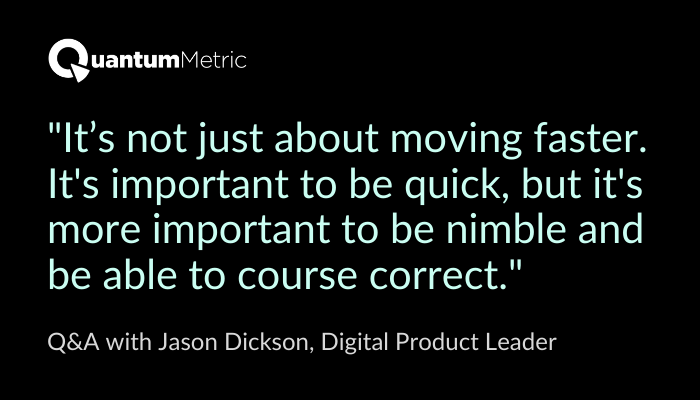Q&A with Jason Dickson, Digital Product Leader at Hilton, Expedia

Jason Dickson is a digital product leader with over 15 years in the travel and hospitality space. Most recently, he served as Director of Product at Hilton. In this interview with Jason, we talk about why he’s passionate about digital products, what he thinks agile truly means, and a few key principles that guide his product management leadership.
Jason, tell us about your professional background and how you got into digital.
I’ve been in the travel and hospitality space for 15 years now, but most recently with Hilton, where I was Director of Product. I’ve also had past experiences with other travel companies like Expedia and CheapCaribbean.com.
I started my career in finance but I realized that it wasn’t what I wanted to do. This was about 2003. The internet at the time was in its early phases. We had gone through the .com boom and bust, but we were coming out of that and evaluating what this could be and what was sustainable in the long term. I got the opportunity to join the e-commerce team at the company I was with. It was a very exciting time. It was still new and the horizons were open, as far as what this technology could do and how we could change people’s lives.
As time passed, I really became passionate about creating digital products that people love and being able to show how even just small changes within an experience can have huge impacts, both for the customer and for the business. That’s what’s driven my passion.
When you started your career in 2003, the landscape was very different. Over that time, building agile teams has become more common, especially with the success of companies like Google and Amazon and their focus on speed. What did agile look like throughout your career?
Most of the teams that I worked in were very waterfall-focused up until about a few years ago. I’ve also worked in teams that have said they’re agile, but really weren’t agile except during the delivery process.
The teams that I felt were truly agile, and most effective and efficient, were the ones that were small, autonomous teams empowered to identify and figure out the best way to solve specific customer problems.
These customer problems may have been identified from leadership or through OKRs, and would stay at a high level. For instance: “Okay, this is what we’re trying to solve for. This is how we’re going to measure whether we’re successful at it.” But then, ultimately, leaving how that’s done up to these teams to be able to really figure that out for themselves.
What are some of the most common frustrations you and other digital leaders have to deal with on a day-to-day basis?
One thing that always has been a frustration for me is not really having a clear view into what our customers experience, either because we don’t have the appropriate data to be measuring that or we know there’s problems, but we don’t know what they are. We just don’t have that insight into that customer experience.
That’s been kind of a big passion for me throughout my career: being able to have the appropriate tools in place to really understand what that experience is.
Another concern I think about often is missing the forest for the trees. Sometimes in digital we can become so focused on optimizing and working in the weeds that we miss the bigger picture. I’ve led teams in the past that have done A/B testing and multivariate testing. A lot of times we’ll get into a cycle where we’re just testing everything.
Sure, maybe the green button provides a 2% lift and click through but being so focused on the details, we miss the bigger picture. In doing so, we set ourselves up to be primed for disruption or lose market share because somebody else is coming in who’s more innovative than we are.
We’ve talked to you about Quantum Metric’s perspective on Continuous Product Design, which is all about teams being able to learn fast and move fast based on customer signals. Can you talk about why you think that’s important?
In this age of digital transformation and disruption, if you and your teams aren’t being innovative or solving your customer needs, customers will quickly go to go to a competitor or you’re going to be disrupted by somebody else that is better able to to serve those customer needs.
But it’s not just about moving faster. It’s obviously important to be quick, but it’s more important to be nimble and able to course correct.
Maybe something in the marketplace has changed or a competitor is doing something new. You might have put out this new product that you were so excited about but it’s not meeting expectations. Now you need to quickly dig into understand why that is, understand what’s driving that, and be able to quickly make changes to course correct and get to a better outcome.
What have you found most often gets in the way teams working together and be nimble as you described? Product is obviously just one part of the customer and digital experience.
There’s a few reasons for that. In some cases it’s not having all the different stakeholders aligned on a common vision. Your marketing team has their own KPIs, digital has their own, or sales team has theirs. There’s not having a shared vision of what this product should be and what you should all be working toward.
Sometimes you don’t have the appropriate data to really be able to make impactful decisions and really inform your product roadmap. You don’t understand what your customers experience, how they’re using something, what they feel about it.
Or, you have data, but you don’t have enough to prioritize things. For example, a common issue is that you may hear from customers that they’re having trouble booking something on the website. You have no idea why they’re getting that error and your production teams can’t troubleshoot it. As a result, it’s hard for you to be able to prioritize that and say: “This should be more important than this other initiative that we have going on.”
That’s where I think having a combination of tools like voice of customer, session replay and analytics all working together can really help fill in some of those gaps and help you understand what that experience is and what the issues are. (Bill’s note: Jason wrote about this exact topic at this blog post: An invaluable trifecta of insights for every product leader.)
Finally, sometimes it’s lack of customer focus. We all have these different priorities within our businesses to drive X lift here and X lift there. But sometimes we lose focus about what’s important for the customer, and as a result, we’re not solving their needs.
Readers, there is so much more to this interview. If you’re a digital product leader, you’ll really enjoy listening to our 30-minute conversation and learning from Jason’s 15 years of experience building great digital products.







